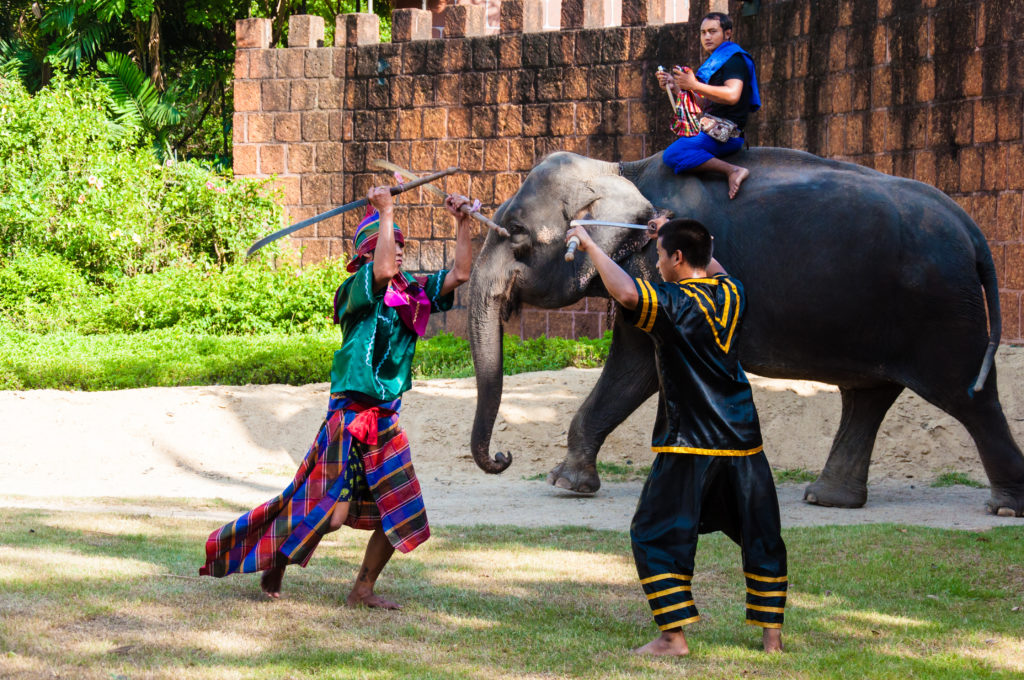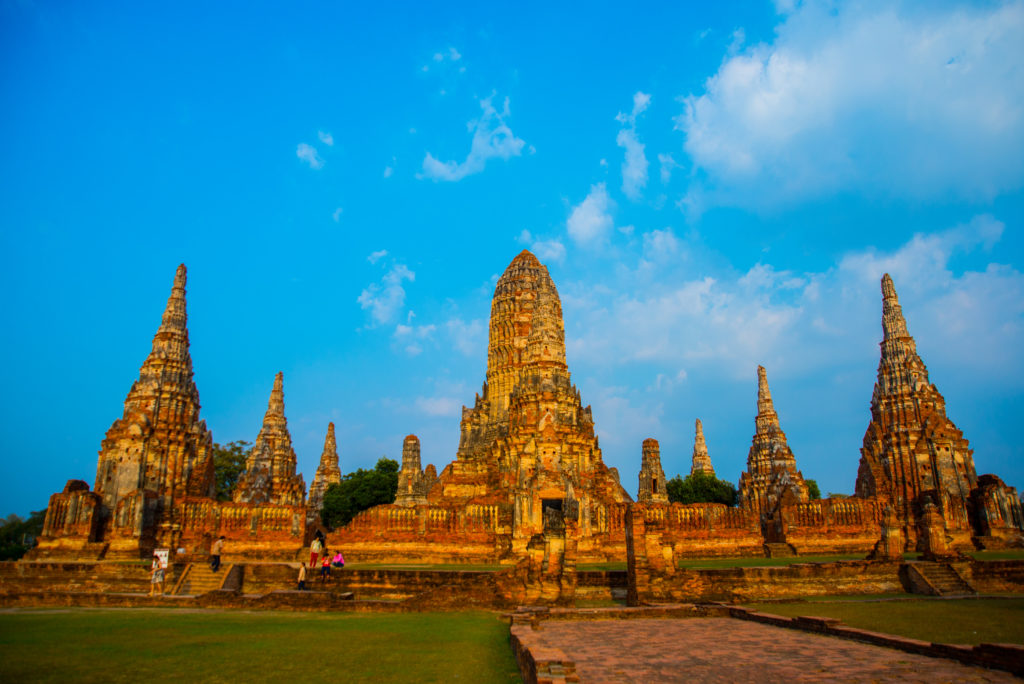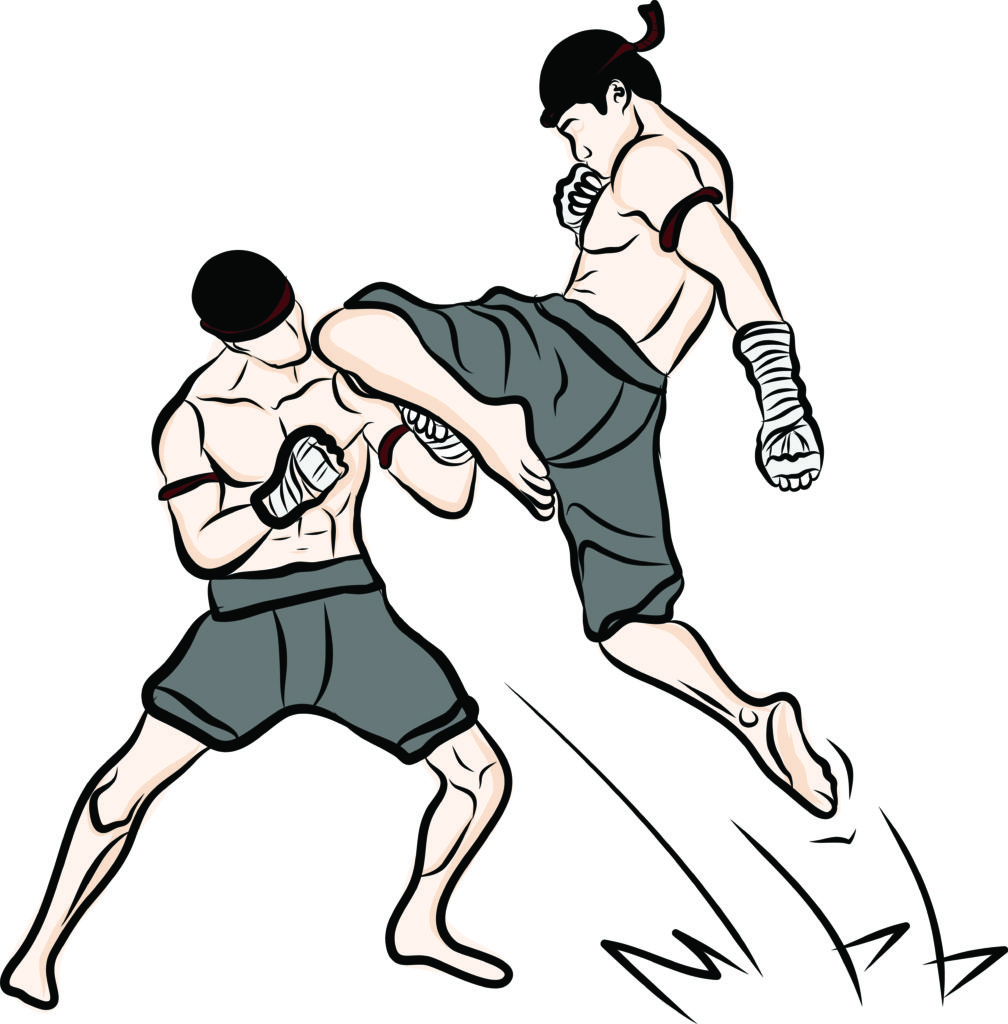The literal translation of the term muay boran is ‘ancient boxing’.
The ‘ancient boxing’ art has a long history rooted in battlefield fighting and ancient combat.
In peace time, muay boran was developed as a system to organize contests to choose the best of the warriors who were then selected as the King’s guards.
As the Art of 8 Limbs, muay thai has only been around since the 1920s when rules and regulations that were standardized much to the same degree as in Western boxing with weight classes, gloves, the Western boxing ring and timed rounds.
Muay boran however has been in existence much, much longer.
Origins of Muay Boran
The origins of Thailands ‘ancient boxing’ lie in the battles fought by warriors of the Siam Kingdom.
Siam was the original name of Thailand and over centuries the Siam Kingdom went through different dynasties. Some of the well recorded history of Siam included the reigns of:
- (1238–1351) Sukhotahi Kingdom
- (1351–1767) Ayutthaya Kingdom
- (1768–1782) Thonburi Kingdom
- (1782–1932) Rattanakosin Kingdom
As the Siam Kingdom expanded under different rulers, wars were fought with the Khmer (Cambodia today), Burma or Myanmar and Lanna which is now the Northern regions of Thailand such as Chiang Mai.
Siam warriors were trained in the old styles of boran which included the use of weapons such as swords, spears and staffs.
The martial arts today which use the weapons in their practice and forms are known as Krabi Krabong.

It was when a combatant was weaponless that they resorted to the muay boran techniques which are the unarmed forms of combat used by Siamese warriors.
A very famous story about Thailands ‘ancient boxing’ comes from the late 18th century.
It tells of the Siamese warrior, Nai Khanom Tom who was captured along with thousands of other Siamese warriors, by the Burmese king Mangra. This was following the Burmese invasion of Siam, then known as the Ayutthaya Kingdom.
At the event of a festival the Burmese King wished to see how Siam boxing or muay boran would stand against Burmese boxing. Kai Khanom Tom was selected to fight the Burmese boxing champion. Nai Khanom Tom knocked out the Burmese boxer.
The story tells that the Burmese King had Nai Khanom Tom fight another 9 Burmese boxers in a row without any breaks, and they were each beaten by the Siam warrior.

The Burmese King then release Nai Khanom Tom and the other captured Simaese warriors. To this day, that historic moment in muay boran history is celebrated in Thailand as National Boxing Day on March 17th.
Whether the story is factual or not we cannot know for sure. However Nai Khanom Tom is still highly respected and regarded as one of the founding fathers of modern muay thai.
Muay Boran Styles
The name itself ‘ancient boxing’, encompasses many different styles each with unique elements. However they are all unarmed combat arts utilizing the 8 limbs as in muay thai but with inclusion of headbutts.
Thus muay boran is also known as the Art of 9 Limbs.

There are generally four recognized styles and each are unique in their forms but also distinct in that they come from different geographic regions in Thailand.
1. Muay TahSao (North Thailand)
Also known as Muay Theen Ling or Monkey Feet Boxing or Ling Lom Windy Monkey. Muay TahSao is known for agile movements and fast kicks.
Versatile and adaptive footwork is also a key feature and muay thasao boxers are trained to fight interchangeabley from both stances.
A uniquely high guard is held in this style of boxing with the lead hand higher than the rear.
2. Muay Korat (North-East Thailand)
Coming from the North-East of Thailand, muay korat boxers specialize in powerful punches and strong kicks.
The ability to circle the opponent and throw powerful strikes from different angles is a characteristic of this style.
The source of this style came is said to have from martial techniques developed in ancient Cambodia during the Khmer’s reign.
A well known training technique of the muay korat roundhouse kick was to kick banana trees for a long period of time to train technique and power.
3. Muay Chaiya (Southern Thailand)
Chaiya is a district and town in southern Thailand and provides the origin of the name of this muay boran style.
Legend states that muay chaiya was developed by the Chinese monk, Phor Than Mar who traveled to Chaiya and stayed in the village of Pum Riang. Other stories say that Phor Tan Mar was a warrior from Bangkok who then became a monk.
This style places great emphasis on low level kicks, with short, precise trajectories. .

The style emphasizes evasiveness to avoid attacks and attack your opponents vulnerable areas.
The style was taught by King Rama to the common towns people and as such it requires less training and conditioning and can be used against those who are stronger and heavier.
This makes this style well suited for self-defense.
4. Muay Lopburi (Central Thailand)
Muay Lopburi originates from Lopburi province in Central Thailand.
The style is known for aggressive punching and quick, evasive footwork.
The typical stance of Muay Lopburi looks very similar to the stance of an 1800s Western boxer. This would be the upright stance with arms pointing forward rather than turned in and guarding your face and head.
A unique technique of this style is the ‘unturned punch’ which strikes out straight from the unique stance with forearms facing forward.
This style is based in very accurate and deadly punches.
The premier Ajarn (teacher) of this dangerous style was called “Muun Men Mat”, meaning “Ten Thousand Accurate Punches”.
Where to Learn Muay Boran Today
Today, unfortunately there are few gyms in Thailand that teaching this ancient style of boxing.
This is due to the lack of willing students who want to learn and who then would pass it on to the next generations.
The popularity and success of muay thai today with modern rules has seen the old muay boran styles suffer with less people wanting to learn them.
However the gyms and resources below are some that are still available to everyone who wants to learn Thailand’s ancient boxing art.

Tiger Muay Thai Gym
The famous Tiger Muay Thai camp in Phuket Thailand, has dedicated muay boran teaching and instruction. Kru Oh, one of the few teachers of muay boran still spreading the art with over 20 years of experience in Thai martial arts.
Rawai Muay Thai Gym
Rawai Muay Thai gym is another gym in the south of Thailand that offers instruction in muay boran. The instructors at Rawai are certified to teach muay boran and they only teach private classes and not in groups.
Rawai offers a specialized 10 hour course that includes:
- Learning the Muay Boran Wai Kru: the dance before the fights
- Learning fundamental Muay Boran fighting techniques
- Learning to tie the rope hand wraps
- Learning to make the mongkol (head amulet)
Kombat Group Thailand
Kombat Group Thailand located in Pattaya, just south of Bangkok also offers muay boran teaching and instruction.
The teacher, Kru Yai, was a student of Mr. Yod Thong Sivaralak himself, one of the best Muay Thai Boran teachers in Thailand; from him Kru Yai was able to learn all the secrets of this ancient and super effective martial art.
https://www.kombatgroup.com/muay-thai-boran
Luktupfah Muay Thai Academy
Located in Bangkok, Luktupfah academy is an accredited academy by Thaland’s Ministry of Education.
Luktupfah believes in spreading and preserving muay boran and as such classes are open to anyone. The classes are more technical and slower paced than their muay thai sessions.
The technique as well as the thai name, meaning and historical context of each is taught to give students a complete understanding of the muay boran they teach.
Group classes are held form Mon-Fri at 10am.
http://luktupfah.com/muay-boran
International Muay Boran Academy IMBA
The IMBA is the first international school devoted to the development of traditional Thai unarmed fighting disciplines (since 1993).
The IMBA has several locations across the world including the first schools in Italy and Spain and other branches in Holland, Germany, Austria, England, Romania, Poland, Greece, Norway, Switzerland, Finland, Australia, Mexico, Argentina, Colombia, Brasil, Peru, USA.
YouTube – Muay Boran Academy
The channel Muay Boran Academy on academy is another source of muay boran instruction that you can learn from without having to visit Thailand.
Their mission is to provide quality instruction and training in the Martial Arts concepts, techniques, and methodologies of ancient Muay Thai aka Muay Boran.
They have over 100 instructional videos of muay boran techniques.



